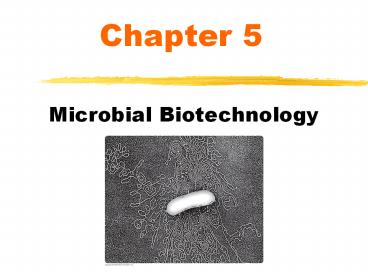Microbial Biotechnology PowerPoint PPT Presentation
Title: Microbial Biotechnology
1
Microbial Biotechnology
- Chapter 5
2
The Structure of Microbes
- Prokaryotes
- Archaebacteria
- Includes halophiles, thermophiles,
extremophiles - Eubacteria
- On skin, soil, water, can be pathogenic
3
The Structure of Microbes
- Characteristics of Prokaryotes
- Generally smaller than Eukaryotes
- No nucleus
- Cell wall composed of peptidoglycan
- Conjugation (transfer of DNA by cytoplasmic
bridge) - Transduction (DNA is packaged in a virus and
infects recipient bacterial cells) - 20 minute growth rate (binary fission)
4
Yeast are Important Too!
- Single celled eukaryote
- Kingdom Fungi
- Over 1.5 million species
- Source of antibiotics, blood cholesterol lowering
drugs - Able to do post translational modifications
- Grow anaerobic or aerobic
- Examples Pichia pastoris (grows to a higher
density than most laboratory strains), has a no.
of strong promoters, can be used in batch
processes
5
Microorganisms as Tools
- Microbial Enzymes
- Taq (DNA polymerase), cellulases, proteases,
amylases
6
Microorganisms as Tools
- Bacterial Transformation
- The ability of bacteria to take in DNA from their
surrounding environment - Bacteria must be made competent to take up DNA
7
Microorganisms as Tools
- Cloning and Expression Techniques
- Fusion Proteins
8
Microorganisms as Tools
- Microbial Proteins as Reporters
- Examples the lux gene which produces luciferase
- Used to develop a fluorescent bioassay to test
for TB
9
Microorganisms as Tools
- Yeast Two-Hybrid System
- Used to study protein interactions
10
Using Microbes for a Variety of Everyday
Applications
- Food Products
- Rennin used to make curds (solid) and whey in
production of cheese - Recombinant rennin is known as chymosin (first
recombinant food ingredient approved by FDA)
11
Using Microbes for a Variety of Everyday
Applications
- Food Products
- Energy production in bacteria
- Aerobic or anaerobic
12
Using Microbes for a Variety of Everyday
Applications
- Food Products
- Fermentation
- (anaerobic respiration)
- Lactic acid fermentation
- Used to make cheese, yogurt, etc.
- Ethanol fermentation
- Used to make beer and wine
13
Using Microbes for a Variety of Everyday
Applications
- Field Applications of Recombinant Microorganisms
- Ice-minus bacteria (remove ice protein producing
genes from P. syringae) - P. fluorescens containing the gene that codes for
the bacterial toxin from Bacillus thuringiensis
(kills insects) Bt toxin!
14
Using Microbes for a Variety of Everyday
Applications
- Therapeutic proteins
- Recombinant insulin in bacteria
15
Using Microbes for a Variety of Everyday
Applications
- Using Microbes Against Other Microbes
- Antibiotics
- Act in a few key ways
- Prevent replication
- Kill directly
- Damage cell wall or prevent its synthesis
16
Vaccines
- First was a vaccine against smallpox (cowpox
provides immunity) - DPT-diphtheria, pertussis, and tetanus
- MMR measles, mumps, and rubella
- OPV- oral polio vaccine (Sabin)
17
Vaccines
- A Primer on Antibodies
- Antigen- foreign substances that stimulate an
immune response - Types of leukocytes or white blood cells
- B-lymphocytes antibody-mediated immunity
- T-lymphocytes cellular immunity
- Macrophages cell eating (phagocytosis)
18
Vaccines
- Antigens stimulate antibody production in the
immune system
Light chain
Heavy chain
IgA first line of defense IgG and IgM
activates macrophages
19
Vaccines
- Mechanism of Antibody Action
20
Vaccines
- How are vaccines made?
- They can be part of a pathogen (e.g. a toxin) or
whole organism that is dead or alive but
attenuated (doesnt cause disease) - Subunit (toxin) or another part of the pathogen
- Attenuated (doesnt cause disease)
- Inactivated (killed)
- What about flu vaccines (why do we have to get a
shot every year?)
21
Recombinant Vaccines
- Vaccines provide immunity to infectious
microorganisms
Attenuated Vaccine
Inactivated Vaccine
Subunit Vaccine
22
Recombinant Vaccines
- Recombinant Vaccines
- A vaccine produced from a cloned gene
Video Constructing Vaccines
23
Recombinant Vaccines
- DNA vaccines
- Direct injection of plasmid DNA containing genes
encoding specific antigenic proteins
24
Bacterial and Viral Targets for Vaccines
- HIV
25
Microbial Genomes
- Microbial Genome Program (MGP) the goal is to
sequence the entire genomes of microorganisms
that have potential applications in environmental
biology, research, industry, and health - Sequencing Strategies?
26
Microbial Genomes
- Why study viral genomes?
- Decipher genes and their products so that agents
that block attachment, block replication can be
made
27
Microbial Diagnostics
- Using Molecular Techniques to Identify Bacteria
- RFLP
- PCR and Real time PCR
- Sequencing
28
Molecular Diagnostics
- Application Molecular Epidemiology
- Pulse Net monitors disease outbreaks related to
different strains of food-borne pathogens
29
Microbial Diagnostics
- Microarrays for tracking contagious disease
- PulseNet used to identify outbreaks
30
Microbial Diagnostics
- Combating Bioterrorism
- The use of biological materials as weapons to
harm humans or animals and plants we depend on
for food - Examples in History
- Throwing plague infected dead bodies over the
walls of their enemies
31
Microbial Diagnostics
- Using Biotech Against Bioweapons
- Postal service x-raying packages
- Antibody tests in the field
- PCR tests in the field
- Protein Microarrays for detecting bioweapon
pathogens

